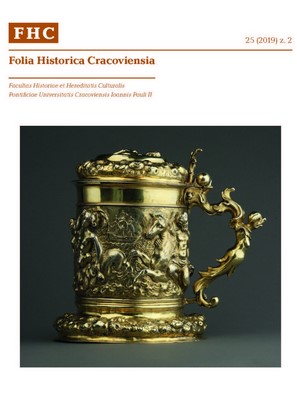The Gift of Emperor Michael, Papal Textiles with Chrysoclabas and Figurative Art in the Period of Iconoclasm
The Gift of Emperor Michael, Papal Textiles with Chrysoclabas and Figurative Art in the Period of Iconoclasm
Author(s): Piotr Ł. GrotowskiSubject(s): Cultural history, History of Church(es), Visual Arts, 6th to 12th Centuries, History of Art
Published by: Wydawnictwo Naukowe Uniwersytetu Papieskiego Jana Pawła II w Krakowie
Keywords: samite; Sancta Sanctorum; Iconoclasm; Book of Pontiffs;
Summary/Abstract: On Christmas of the year 811, Emperor Michael I Rangabe solemnly crowned his elder son Theophylact in the church of Hagia Sophia. On this occasion, he offered numerous precious gifts to the cathedral, which included a set of four curtains embroidered with gold and purple. Sacred images were depicted on them. These textiles have not survived to our times, and are known to us only thanks to the short record in the Theophanes’ Chronicle. However, it is possible to reconstruct their form on the basis of their preserved contemporary examples. The practice of donating silks decorated with figural religious motifs to churches is confirmed by the Book of Pontiffs. The source mentions gifts given by popes Hadrian I (772–795), Leo III (795–816), Paschal I (817–824), Gregory IV (827–844) and Leo IV (847–855) to shrines in Rome and Ravenna. The textiles mentioned by that source include both those decorated with ornamental motifs (griffins, crosses), and those adorned with evangelical scenes (Annunciation, Nativity, Entry into Jerusalem, Passion, Ascension, Descent of the Holy Spirit), as well as images of Christ and saints. The word chrisoclabum (or chrisoclavum), repeated in written sources, seems to relate to compositions placed inside medallions, and perhaps also to exceptionally precious appliqués of gold and purple fastened to the textile background. As early as 75 years ago, Wolfgang F. Volbach sought to associate two pieces of silk samite with the Annunciation and Nativity scenes (kept at the Vatican Museo Sacro; initially dated to the 6th century.) with papal gifts from the turn of the 8th and the 9th century. His hypothesis, accepted by most scholars, has recently been disputed by Anna Muthesius, who suggests a later date for both silks (after 843). Due to this fact, it seems necessary to offer a new analysis and interpretation of both textiles that will rely on the current body of knowledge about the Byzantine art of the 8th and the 9th century.
Journal: Folia Historica Cracoviensia
- Issue Year: 25/2019
- Issue No: 2
- Page Range: 9-43
- Page Count: 35
- Language: English

